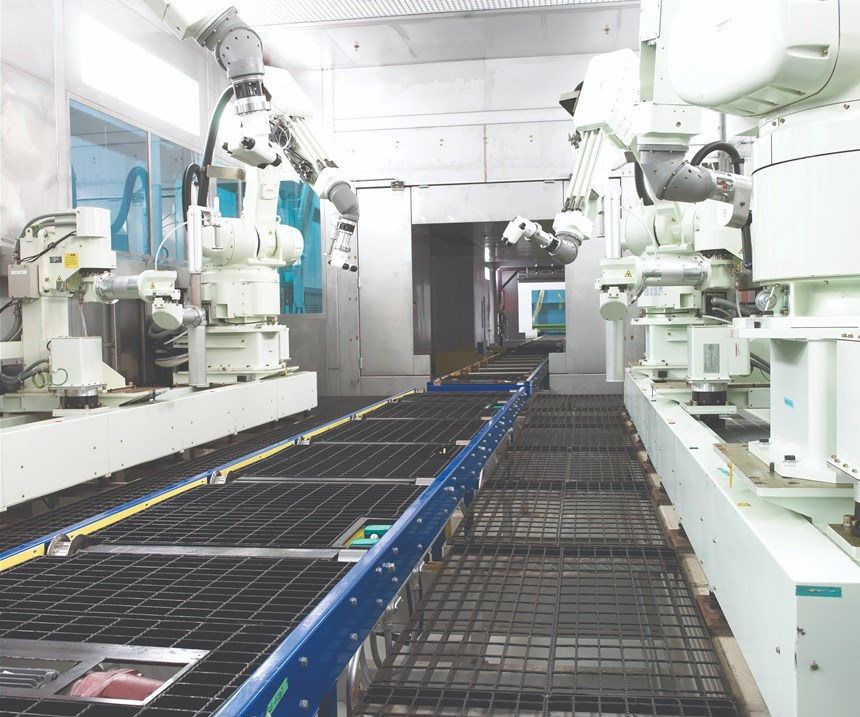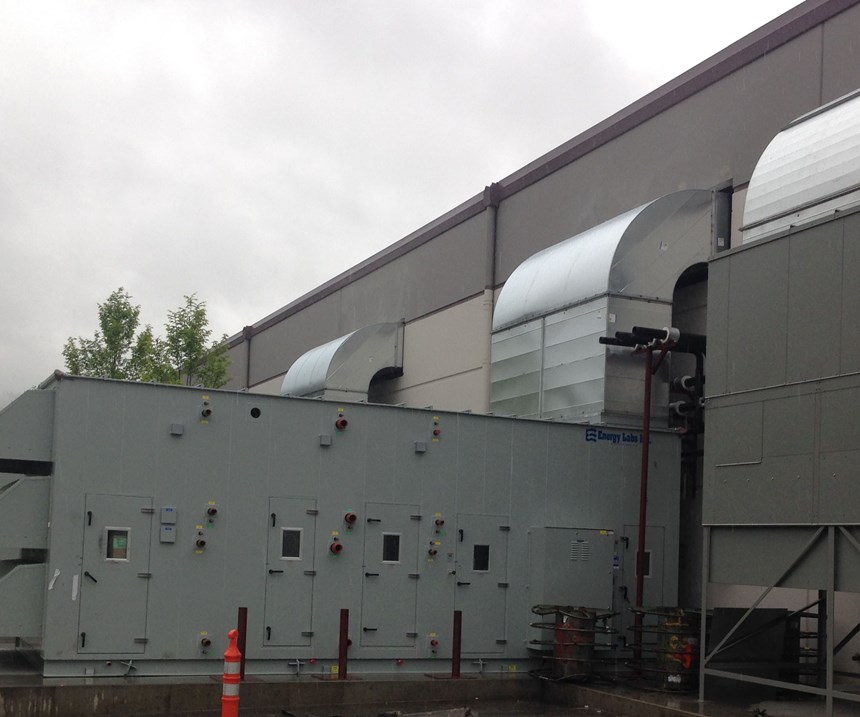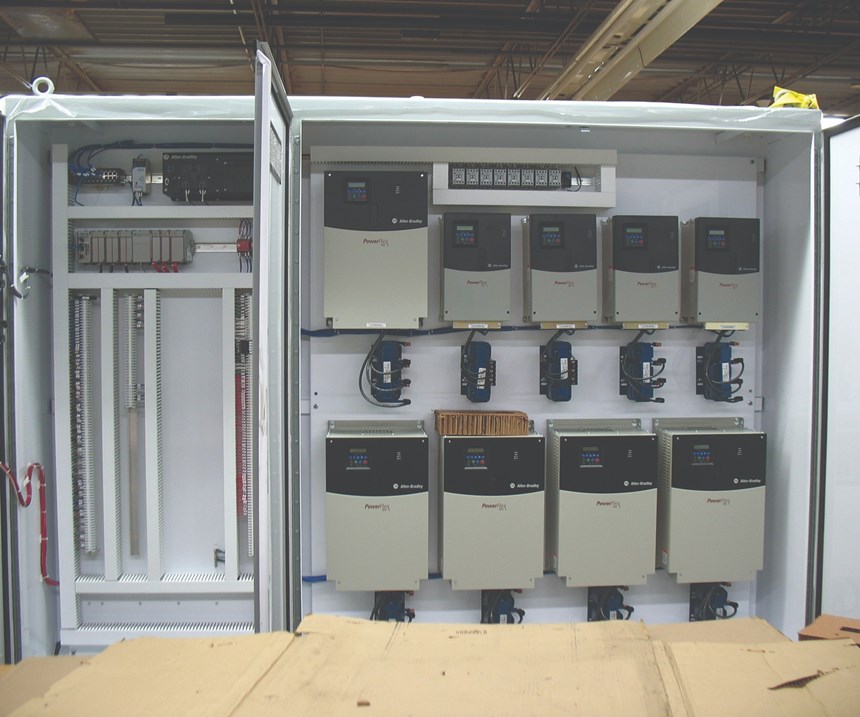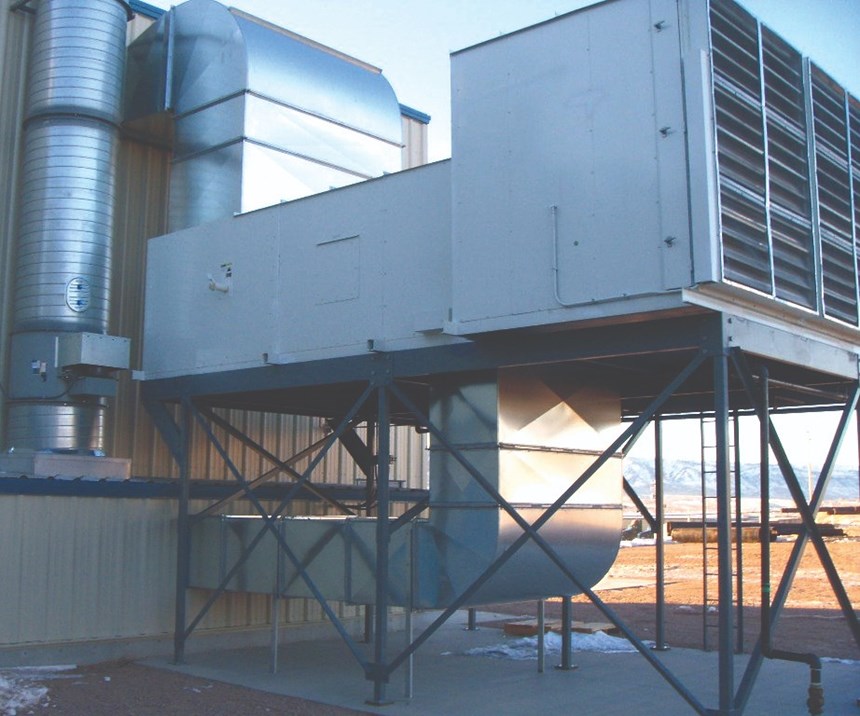Every liquid or powder coating operation has different climate averages for temperature and humidity, and a shop needs the correct climate conditions to minimize coating defects on parts. Some coating processes are so critical that failure of the coating is just not acceptable, and when a job requires 24/7 production, it is not possible to wait until climate conditions are “just right.” In addition, some coatings show failure immediately when they are applied in too hot/dry, too hot/humid or too cold a climate.
If climate control is needed, it should start with specification of the temperature with acceptable variation (for example, 78°F with +/-5°F) and relative humidity with acceptable variation (say, 65 percent, with +/-10 percent).
Air make-up units (AMUs) can provide that climate control and dehumidification for replacement air. There is no one system that fits all, as each should be customized for the location, climate variations and coating variables. Codes also require replacement air for air that is exhausted from a booth or facility.
How AMUs Work
When relative humidity (RH) is too high, AMUs cool the air to remove moisture and thereby reduce the humidity in the air going into the spray booth or paint system. The air velocity through the AMU is reduced so the moisture (water) drops into a pan and doesn’t get blown down the duct. This makes the size of the AMU unit larger; coils and other apparatuses may also increase as determined by the specifications.
When RH is too low, such as in very hot, dry climates (think Phoenix), or very cold, dry climates (think Minneapolis), the air is so dry that it can flash off the moisture from the coating before it can be applied to the part. In these cases, the raw air is pulled into the AMU through filters, then passes over the cooling coils. The air may need to be cooled below the spray temperature required in the spray booth to remove the moisture, then it is reheated to bring it back up to the right temperature for spraying.
Typical Costs
An AMU in an “ideal” climate, like Southern California, would likely require unheated, filtered airflow at a cost of about $0.50 to $1.00 per cfm (cubic foot per minute). So, if the volume of air required is 20,000 cfm, for example, the cost would be $10,000 to $20,000.
The cost of a typical AMU with gas heat (direct-fired burner), providing heated, filtered air, would be about $0.75 to $2.00 per cfm, or $15,000 to $40,000 for our 20,000-cfm example, depending on the amount of duct required, the installation area and other factors.
For hot, dry climates where it never really gets cold, an AMU with a direct-fired burner and an evaporated cooler would likely be recommended, at a cost of about $2.00 to $4.00 per cfm ($40,000 to $80,000 for required air volume of 20,000 cfm).
To help better understand the complexities involved in choose the right AMU, a shop would be well-advised to get a psychometric chart and better understand the terms relative humidity and temperature uniformity.
The amount of duct needed for air supply or intake will also affect costs, as will the piping for chilled or hot water running to the AMU. Other considerations are coolant gases, the location of the compressor relative to the AMU, as well as the weight of the equipment vs. the capacity of the building’s roof. The power supply to the HVAC equipment and control wiring will also affect costs. And don’t forget the footprint of this equipment; it can be as much or more square footage than the spray booths.
Reducing Costs
There are ways to lower costs associated with AMUs. For example, is there already chilled water, or hot water or steam in the facility with extra capacity for the new system? Other cost-reduction considerations include:
- Simple dehumidification, which involves cooling to condense water from the air and then reheating to 70°F/80°F for painting at $10 to $20 per cfm. (So the unit/system cost for 20,000-cfm air volume would be $200,000 to $400,000, not installed.)
- Re-humidification would add another $10 to $20 per cfm ($200,000 to $400,000). This is different from dehumidification, where it is hot and dry and water evaporates quickly and easily. This is for cold and dry climates, where you need to heat the water (boil it/turn it to steam) and put it into the airstream properly, so it doesn’t rain in your booth.
There are exceptions and conditions that impact these cost savings: A smaller-cfm system can cost disproportionally more because the per-cfm “rule” is skewed and a large system has more cfm to dilute the dollar figure. There are many reasons systems cost so much, including indirect fired burners, boilers, chillers and re-humidification. For boilers/chillers, additional costs include piping, tanks, water treatment, freeze protection, modifications to support the weight of unitsand weight of water (8.64 pounds per gallon), to name a few. All of this equipment has a fairly large footprint, and it can be located some distance from the booth it is supplying.
(A note on freeze protection: If the installation climate for a chiller is cold, a shop must add freeze protection. This protects the units from burst pipes and coils, but also it takes away capacity, which means a shop may have to upsize the unit capacity to allow for the proper amount of heating/cooling. This, of course, affects the unit’s price.)
There are ways a facility can reduce costs while meeting specifications. One way is by recirculating the air of the spray booth. For 20,000-cfm exhaust, for example, you can recirculate 80 percent (16,000 cfm) and exhaust 20 percent (4,000 cfm). This saves considerable money, since 4,000 cfm times $40 per cfm equals $160,000; the worst-case $800,000 is reduced by $640,000. So recirculation, if allowed, can greatly reduce costs.
Any system will require controls, and this, too, plays into the cost structure. The control system must sense the temperature of the incoming air and its humidity content, and then supply more cooling or heat to the system, in addition to monitoring the conditioned air going to the spray booth and making adjustments.
This control system typically controls:
- Spray booth demand for air.
- Spray booth filter loading with overspray.
- Spray booth exhaust fans and speed.
- Cooling, chiller output or the mechanical air conditioning system.
- Heating unit, burners or boilers.
- All safety sensors if the booth is using recirculation of exhaust air to reduce the exhaust volume.
Location, Location, Location
Every location has a climate average for temperature and humidity, as well as an average maximum and minimum of temp/humidity. It’s critical to have the correct climate conditions for your finishing system/spray booths so that defects are minimized.
Paint equipment can all be dialed into the optimum range for a Class A finish, but the wrong climate can make all those efforts ineffectual.
Most HVAC manufacturers use information from the American Society of Heating, Refrigerating and Air-Conditioning Engineers (ASHRAE) to determine climate variations and design the type of system needed for a specfic location. A particular shop’s location and specifications will determine the type of system that will best meet its needs.
Marty Powell is in technical systems sales for Carlisle Fluid Technologies. He can be reached at mpowell@carlisleft.com or 419-276-5969.
Related Content
The Value of Robotic Paint Performance Testing
Considerations for implementing the use of automation for paint performance testing.
Read MoreFinishing Systems Provider Celebrates 150 Years, Looks to Future
From humble beginnings as an Indiana-based tin shop, Koch Finishing Systems has evolved into one of the most trusted finishing equipment providers in the industry.
Read MoreMasking Solutions Provider CFS Dramatically Expands Capabilities and Capacity
Custom Fabrication & Supplies (CFS) completed a new plant expansion packing 10 times the capacity into twice the space. It dramatically enhances the supplier’s custom capabilities to provide extremely precise and cost-effective masking solutions.
Read MoreProducts Finishing Reveals 2024 Qualifying Top Shops
PF reveals the qualifying shops in its annual Top Shops Benchmarking Survey — a program designed to offer shops insights into their overall performance in the industry.
Read MoreRead Next
A ‘Clean’ Agenda Offers Unique Presentations in Chicago
The 2024 Parts Cleaning Conference, co-located with the International Manufacturing Technology Show, includes presentations by several speakers who are new to the conference and topics that have not been covered in past editions of this event.
Read MoreEpisode 45: An Interview with Chandler Mancuso, MacDermid Envio Solutions
Chandler Mancuso, technical director with MacDermid Envio discusses updating your wastewater treatment system and implementing materials recycling solutions to increase efficiencies, control costs and reduce environmental impact.
Read MoreDelivering Increased Benefits to Greenhouse Films
Baystar's Borstar technology is helping customers deliver better, more reliable production methods to greenhouse agriculture.
Read More



















.jpg;maxWidth=300;quality=90)







